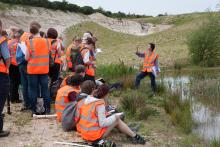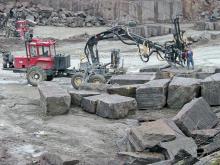
Efforts to improve energy efficiency in any quarry will be furthered by a new EU-funded project now underway. Claire Symes met with the EE-Quarry project leader Antonio Barona to find out more.
When you think of energy efficiency and quarries, you might not link these thoughts with an office block in a newly built district on the northern edge of the Spanish city of Madrid.
Nonetheless, this is the centre point drawing together pan-European expertise for a project that is aiming to deliver lower energy demands and high productivity for the aggregates sector.
Madrid-based consulting firm
The aim of the project seems at first thought to be simple but, if successful, could be far reaching - to develop a new modelling and monitoring energy management system technique in order to improve energy efficiency and move to low CO2 emissions in the non-metallic mineral industry.
"The EE-Quarry project comes from the necessity to control a very demanding energy intensive industry, which is characterised by its high energy demands and large CO2 emissions," said Solintel research and development manager Antonio Barona. "The goal is to improve energy efficiency and to reduce CO2 produced by quarries.
"Given the market size, ample resources and stable growth potential of this industry, the understanding and dissemination of energy efficiency opportunities is paramount for European energy efficiency goals. The aim of the project is to create a model that can be applied to any quarry."
Although Solintel has only been operating for three years, its multidisciplinary engineering team has wide experience of working on EU-funded project and alongside the EE-Quarry initiative the company is active in a number of other schemes. Nonetheless, this is the first project that Solintel has led and it is clear that Barona is excited by not just this factor as he lists the key dates in getting funding approval but also the whole aim of the project.
"We were competing against a lot of other industries to get this energy efficiency research funding as part of the EU's Framework Programme 7," he said. There were bids from the paper and steel industry - both of which are also energy intensive but our proposal was selected over these."
Solintel first saw the potential for improving energy efficiency in quarries after carrying out some consultancy work for a quarry operator in Southern Spain, which looked at quality and efficiency issues and their impact on productivity.
Up to this point, Columbian-born Barona's main involvement with the quarrying industry was in terms of aggregate and ready mixed concrete quality. "I have always been interested in the quarrying industry though," he said. Barona has a degree in civil engineering from Pontifical Javeriana University in Columbia but also has a masters in construction materials from Institute Eduardo Torroja for Construction Science (CSIC) and a second masters in project management from the Polytechnic University of Madrid.
"While we were working on the Spanish quarry project, we noticed there was a call for a project proposer for the energy efficiency and we thought it was a good chance to increase our knowledge of this sector," he said. "The proposal was submitted in April 2009 but it wasn't until 16 October that year that we got final confirmation of the funding, then we had to submit various legal documents from the different consortium members, which took a year to finalise. The project officially got underway on 1 September 2010 and will run for four years."
Solintel is project managing the scheme but various work packages are being undertaken by the other project partners, who include Spain-based contractor
"The team is fairly small but the work has been balanced between each member to best use their skills and knowledge," said Barona. "Each member is either a work package manager or a task leader for different elements of the project."
Barona's work on the scheme is being supported by newly recruited Solintel staff - mining engineer Laura Sanchez Alonso, who has worked for both
The scheme's management is organised with a general committee, a steering committee and seven work packages and it is in the work packages that the aim of the project becomes clear.
"Solintel is leading the first work package, which concerns the project management," explained Sanchez. "We are working on the overall coordination and governance structure, as well as the communication flow and methods necessary to achieve the project objectives."
The project website - %$Linker:
"CAMT is leading the second work package which is to detect critical and intensive energy demanding processes in the extractive industry and, using energy management system techniques, to provide an optimised solution," continued Sanchez. "This package is a key element of the initial demonstration phase of the work.
"The third package is being led by MIRO and will aim to develop innovative solutions for energy efficiency based on modelling and monitoring all stages involved in the aggregate production process, as well as proposing and validating a set of improvement alternatives, according to the work done on the second work package.
"Increasing energy efficiency opportunities and reducing CO2 impact after production is the focus of the fourth package and is being led by Solintel. This package involves looking at the life cycle of the quarry and considers the CO2 neutralising activities that take place during the restoration phase.
"S&B will lead the fifth package which will look at the implementation benefits of the model," said Sanchez. "The objective here is to demonstrate and apply the solutions developed in the third package of work by using four quarries where operations will be controlled, monitored and evaluated using the systems developed in the second and third work packages. The results will allow us to quantify the real impact and develop the opportunities offered by this project.
"D'Appolonia will lead the sixth package, which will develop the business model and exploit the project results. The final package will be led by the University of Leicester and involves dissemination, education and training in the models developed by the project to ensure maximum benefit in quarries across Europe."
Although the project is only seven months old, the team has already achieved some of the key elements of the critical path plan and the team was in the process of arranging a project meeting with the partners when ABE visited Solintel's Madrid office
"During the meeting we will look at the progress of the different elements and select the four demonstration quarries for the project," said Sanchez. "Although we will not be at the demonstration phase for another couple of years, we felt it was important to be sure we had a good range of quarry operations to trial the model to prove that it is effective. With this in mind, we are aiming to have a number of different rock types, geographical locations and size of companies represented in the testing work."
Although the project has an EU grant, it does not cover the whole project costs and around 40% of this is being contributed by the project partners. "There are considerable benefits to companies who work closely on this kind of project in terms of networking and gaining new knowledge that can be commercialised in other parts of their businesses," explained Barona. "Contribution to the funding helps to ensure everyone's commitment to the work."
The funding from the EU is released sequentially and is linked to the official 18, 36 and 48 month reporting periods which have to demonstrate the progress and results of the project.
Although Barona admits that creating a model that will work in any quarry is a major challenge, it is clear that it is one that he, and his team, are thriving on if their enthusiasm is anything to go by.







